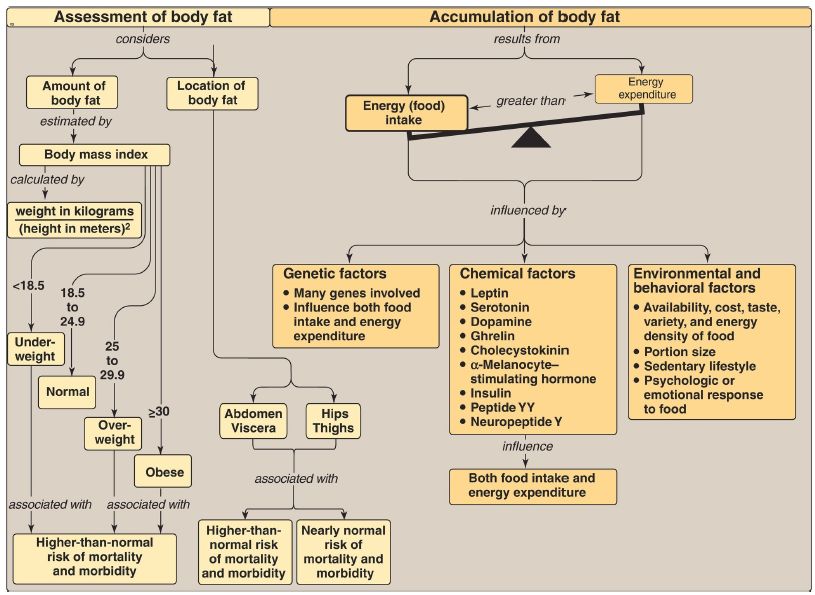


 النبات
النبات
 الحيوان
الحيوان
 الأحياء المجهرية
الأحياء المجهرية
 علم الأمراض
علم الأمراض
 التقانة الإحيائية
التقانة الإحيائية
 التقنية الحيوية المكروبية
التقنية الحيوية المكروبية
 التقنية الحياتية النانوية
التقنية الحياتية النانوية
 علم الأجنة
علم الأجنة
 الأحياء الجزيئي
الأحياء الجزيئي
 علم وظائف الأعضاء
علم وظائف الأعضاء
 الغدد
الغدد
 المضادات الحيوية
المضادات الحيوية|
Read More
Date: 30-10-2021
Date: 29-12-2021
Date: 28-12-2021
|
Obesity
Obesity, the accumulation of excess body fat, results when energy (caloric) intake exceeds energy expenditure (Fig. 1). Obesity is increasing in industrialized countries because of a reduction in daily energy expenditure and an increase in energy intake resulting from the increasing availability of palatable, inexpensive foods. The body mass index (BMI) is easy to determine and highly correlated to body fat. Nearly 69% of U.S. adults are overweight (BMI ≥25), and >33% of this group are obese (BMI ≥30). The anatomic distribution of body fat has a major influence on associated health risks. Excess fat located in the abdomen (upper body, apple shape), as reflected in waist size, is associated with greater risk for hypertension, insulin resistance, diabetes, dyslipidemia, and coronary heart disease as compared to fat located in the hips and thighs (lower body, pear shape). A person’s weight is determined by genetic and environmental factors.
Appetite is influenced by afferent, or incoming, signals (that is, neural signals, circulating hormones such as leptin, and metabolites) that are integrated by the hypothalamus. These diverse signals prompt release of hypothalamic peptides (such as neuropeptide Y and α-melanocyte–stimulating hormone) and activate outgoing, efferent neural signals.
Obesity is correlated with an increased risk of death and is also a risk factor for a number of chronic conditions. Weight reduction is achieved best with negative energy balance, that is, by decreasing caloric intake and increasing physical activity. Virtually all diets that limit particular groups of foods or macronutrients lead to short-term weight loss. Long-term maintenance of weight loss is difficult to achieve. Modest reduction in food intake occurs with pharmacologic treatment. Surgical procedures, such as gastric bypass, designed to limit food intake are an option for the severely obese patient who has not responded to other treatments.

Figure 1: Key concept map for obesity. [Note: Body mass index may also be calculated by weight in pounds/(height in inches)2 × 703.]



|
|
|
|
التوتر والسرطان.. علماء يحذرون من "صلة خطيرة"
|
|
|
|
|
|
|
مرآة السيارة: مدى دقة عكسها للصورة الصحيحة
|
|
|
|
|
|
|
نحو شراكة وطنية متكاملة.. الأمين العام للعتبة الحسينية يبحث مع وكيل وزارة الخارجية آفاق التعاون المؤسسي
|
|
|